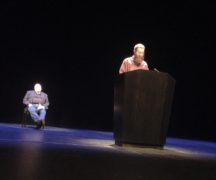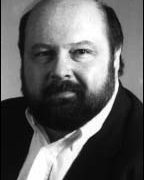By DAVID DUPONT
BG Independent News
Fiction writer Wendell Mayo is a child of the Cold War.
He grew up on intimate terms with the power of the atom. His father was a nuclear scientist who worked not far from home at the NASA Center in Cleveland.
He worked on space applications and nuclear power, which he saw as a boon for the world, his son said.
But the atom’s apocalyptic threat cast a long shadow. Mayo has dealt with the ramifications in short stories inspired by horror movies and others by his stay in Lithuania after the collapse of the Soviet Union.
Now in his fifth collection of stories “Survival House” (Stephen Austin University Press) he brings those concerns home. “I wasn’t interested in writing about the Cold War per se so much as writing about the kind of the lingering psychological effect it has on my characters,” Mayo, 65, said. “I was a Cold War kid. More than ever I’ve started to feel the same awful feelings again. So I decided to start writing about it.”
Some of the stories take place in the 1960s in Cleveland, where Mayo grew up. Others take place in contemporary in Northwest Ohio where Mayo now lives.
Some explicitly make reference to the Cold War. In “Commie Christmas,” a boy tries to convince his brother that Santa is a Communist.
The opening story “Doom Town” imagines a festival in Luckey that celebrates the possibility of nuclear holocaust. It concludes with barbecuing a pig, the same breed as those used to study the impact of an atomic blast on human flesh.
Mayo also imagines in “The Trans-Siberian Railroad Comes to Whitehouse,” a restaurant that has a Soviet-era theme with a toy train that delivers the food.
In both those stories, Mayo grounds the tales, as fanciful as they are, in local communities.
The idea, he said, comes from the news reporting practice of writing articles on local people who have connections, often very tenuous, to global events.
Other stories have less direct connection. Mayo is fascinated by the concept of “the mind of doom” where someone believes that “by making one little misstep it can cause a chain of events that’s cataclysmic.”
That’s true of the character in “Cherry Pie,” which Mayo said is his favorite story in the collection.
In the story, the main character, an older male, offers two poor kids in a local restaurant a piece of pie. The elder brother rebuffs him. The man then feels he was misunderstood, that he was taken as that stranger the boys have been taught to avoid. He obsesses on that thought. He undertakes a series of actions to make his true intentions known, which only cast him in a more suspicious light.
The final story takes him back to Lithuania, and a tour of a nuclear missile silo. That story is based in part on a tour to a site by Mayo and BGSU grad and Pulitzer Prize winner Anthony Doerr. Mayo said he could not bring himself to go into the silo. In the story, the tour guide informs the character that the missile formerly in the silo had been targeted at Cleveland.
That’s where Mayo’s desire to be a writer began. He wanted to be a writer, but his father said that was a silly notion and pressed him to go into science. Mayo attended Ohio State and studied chemical engineering. His father died in 1976, but Mayo was far too along in his studies, and finished the degree and began a career.
Mayo said about 10 years after his father died, his aunt sent him a package of papers from his father. Included were 10-20 poems his father had written in college. They, not surprisingly, were in praise of science and space travel.
Mayo worked as a chemical engineer but he continued save money in hopes of going back to school to pursue writing. He earned a journalism degree from the University of Toledo seeing that as a way to become a writer. But that didn’t take. He even pursued a graduate degree in communications, but he never completed it.
Then in the mid-1980s he attended Vermont College’s low residency program for adult learners, where he earned a Master of Fine Arts in Fiction in 1988.
There he found kindred spirits who’d also taken circuitous routes to becoming writers.
Mayo later earned a doctorate at Ohio University and started teaching on the university level. He came to Bowling Green State University in 1996 to teach in the Creative Writing Program. retiring this past spring.
That retirement will serve to give him more time to write. “I get into a sweet spot where I’m writing stories that satisfy me, and I’m learning something about myself and the world around me. I worry about putting them in a book later.”
While he doesn’t find the work of assembling a collection as enjoyable as writing the stories, it is a valuable, though a sometimes “painful” process.
“When I piece this together I understand more about myself and the world around me than if I’d never done the book,” he said.
In bringing these particular stories together he also came “to understand my old man better, more than I ever did before.”




